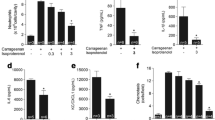Abstract
In the present study, the effects ofβ-adrenergic receptor agonists on the hydrogen peroxide (H2O2) production in phorbol myristate acetate stimulated guinea pig alveolar macrophage suspensions have been investigated. In contrast to suggestions described in literature, our results indicate that the H2O2 production in alveolar macrophage suspensions is not mediated byβ-adrenergic receptors. Rather, it is suggested that the inhibitory effect of catecholamines in the H2O2 formation which is found after 5 minutes is the result of inhibition of the horseradish peroxidase catalysed phenol red oxidation, used as H2O2 measurement, by the catecholamines.
Similar content being viewed by others
References
L. Flohé, R. Beckmann, H. Giertz and G. Loschen,Oxygencentred free radicals as mediators of inflammation. InOxidative Stress. Academic Press, New York, London 1985.
P. A. J. Henricks, B. van Esch and F. P. Nijkamp,β-Agonists can depress oxidative metabolism of alveolar macrophages.Agents and Actions 19, 5–6 (1986).
E. Pick and Y. Keisari,A simple colorimetric method for the measurement of hydrogen peroxide produced by cells in culture. J. Immunol. Meth.38, 161–170 (1980).
F. Engels, R. S. Oosting and F. P. Nijkamp,Pulmonary macrophages induce deterioration of guinea pig tracheal β-adrenergic function through release of oxygen radicals. Eur. J. Pharmacol.111, 143–144 (1985).
D. Palm and D. Hellenbrecht,Pharmakologie des noradrenergen und adrenergen Systems Katecholamine, Sympathomimetika, Receptorenblocker, Antisympathotonika und andere Antihypertensiva. In:Allgemeine und spezielle Pharmakologie und Toxikologie. (Ed. D. Henschler and W. Rummel) pp. 112–155, Bibliographisches Institut, Mannheim 1983.
H. P. Misra and I. Fridovich,The role of superoxide anion in the auto-oxidation of epinephrine and a simple assay for superoxide dismutase. J. Biol. Chem.247, 3170–3175 (1972).
A. Bast and G. R. M. M. Haenen,Cytochrome P-450 and glutathione: what is the significance of their interrelationship in lipid peroxidation. Trends Biochem. Sci.9, 510–513 (1984).
P. A. J. Henricks, B. van Esch, A. J. M. van Oosterhout and F. P. Nijkamp,β-adrenergic agonists diminish hydrogen peroxide release of guinea pig alveolar macrophages. X th Internat. Congress of Pharmacol. Abstract O269, Sydney, 1987.
Author information
Authors and Affiliations
Rights and permissions
About this article
Cite this article
Goeptar, A.R., Haenen, G.R.M.M., Timmerman, H. et al. The effects ofβ-adrenergic receptor agonists on the H2O2 formation in alveolar macrophage suspensions are not mediated byβ-receptors. Agents and Actions 25, 375–377 (1988). https://doi.org/10.1007/BF01965045
Received:
Accepted:
Issue Date:
DOI: https://doi.org/10.1007/BF01965045




